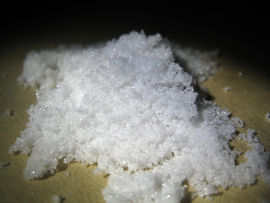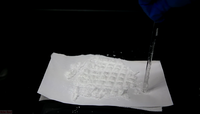Hydrazine sulfate
 Hydrazine sulfate via bleach/urea and methylethylketazine
| |
| Names | |
|---|---|
| IUPAC names
Hydrazinium hydrogen sulfate
Hydrazinium sulfate | |
| Other names
Hydrazine monosulfate
| |
| Properties | |
| N2H6SO4 N2H5HSO4 | |
| Molar mass | 130.12 g/mol |
| Appearance | White solid |
| Odor | Odorless |
| Density | 1.378 g/cm3 |
| Melting point | 254 °C (489 °F; 527 K) (decomposes) |
| Boiling point | Decomposes |
| 3 g/100 ml (20 °C) 14 g/100 ml (80 °C) | |
| Solubility | Insoluble in hydrocarbons |
| Solubility in ethanol | 0.04 g/100 g (25 °C) |
| Vapor pressure | ~0 mmHg |
| Hazards | |
| Safety data sheet | Sigma-Aldrich |
| Lethal dose or concentration (LD, LC): | |
| LD50 (Median dose)
|
601 mg/kg (rat, oral) |
| Related compounds | |
| Related compounds
|
Hydrazine hydrochloride Hydrazine nitrate |
| Except where otherwise noted, data are given for materials in their standard state (at 25 °C [77 °F], 100 kPa). | |
| Infobox references | |
Hydrazine sulfate is a useful salt that finds its use as a non-volatile source of hydrazine.
Contents
Properties
Chemical
Hydrazine hydrate and anhydrous hydrazine are highly carcinogenic, toxic and air unstable compounds however as the sulfate salt, the hydrazine is much more stable and can be handled without much of the safety concerns as pure hydrazine. Hydrazine hydrate is produced when hydrazine sulfate is reacted with a strong base such as sodium hydroxide.
Hydrazine sulfate has the molecular formula N2H6SO4, however this is better represented as N2H5HSO4. It finds uses in organic chemistry, mainly by forming hydrazides.
Physical
Hydrazine sulfate is a white crystalline solid melting at 254 °C.
Availability
Hydrazine sulfate is not very readily available for purchase to the amateur, but it is cheaply made at home.
Preparation
There are many ways in which an amateur can produce hydrazine sulfate. Two important ones which give decent, around 50%, yields are shown below.
Hypochlorite-Ketazine Process
Concentrated (20 - 30%) ammonia is mixed with methyl ethyl ketone and a few hundred mg of gelatin and cooled down to 0°C. Sodium hypochlorite is then added dropwise until the stoichiometric amount has been added. A hydrophobic azine (methyl ethyl ketazine) which is less dense than water, will then separate. This azine is then mixed with a stoichiometric amount of ~17% sulfuric acid, and heated to the boiling point of MEK to ensure full hydrolysis of the azine. Finally, the solution is chilled to 0°C to precipitate the hydrazine sulfate. The solution is then vacuum filtered.[1]
Hoffman Rearrangement of Urea
A solution of 10% sodium hypochlorite is added to solid sodium hydroxide and the mixture is kept cold during the addition. Meanwhile, a solution of urea with a few hundred mg of gelatin is prepared. The two solutions are mixed and allowed to fully react, a voluminous foam will appear. After they have reacted, MEK is added to the solution and the azine is processed as previoulsy described.[2]
Projects
When mixed with a solution of silver nitrate, a silver mirror will be formed on the surface of the container. Hydrazine sulfate also finds a variety of uses in organic syntheses such as the preparation of 2,4 dinitrophenylhydrazine, and the preparation of luminol.
Free based hydrazine can be used in the production of sodium azide.
Handling
Safety
Hydrazine sulfate is much safer than its free base, hydrazine. However, it is still moderately toxic and a suspected carcinogen. It may ignite on contact with certain strong oxidizers.
Storage
Hydrazine sulfate can be safely stored in glass or plastic bottles, away from alkali.
Disposal
Hydrazine sulfate can be neutralized with a diluted solution of calcium hypochlorite.
